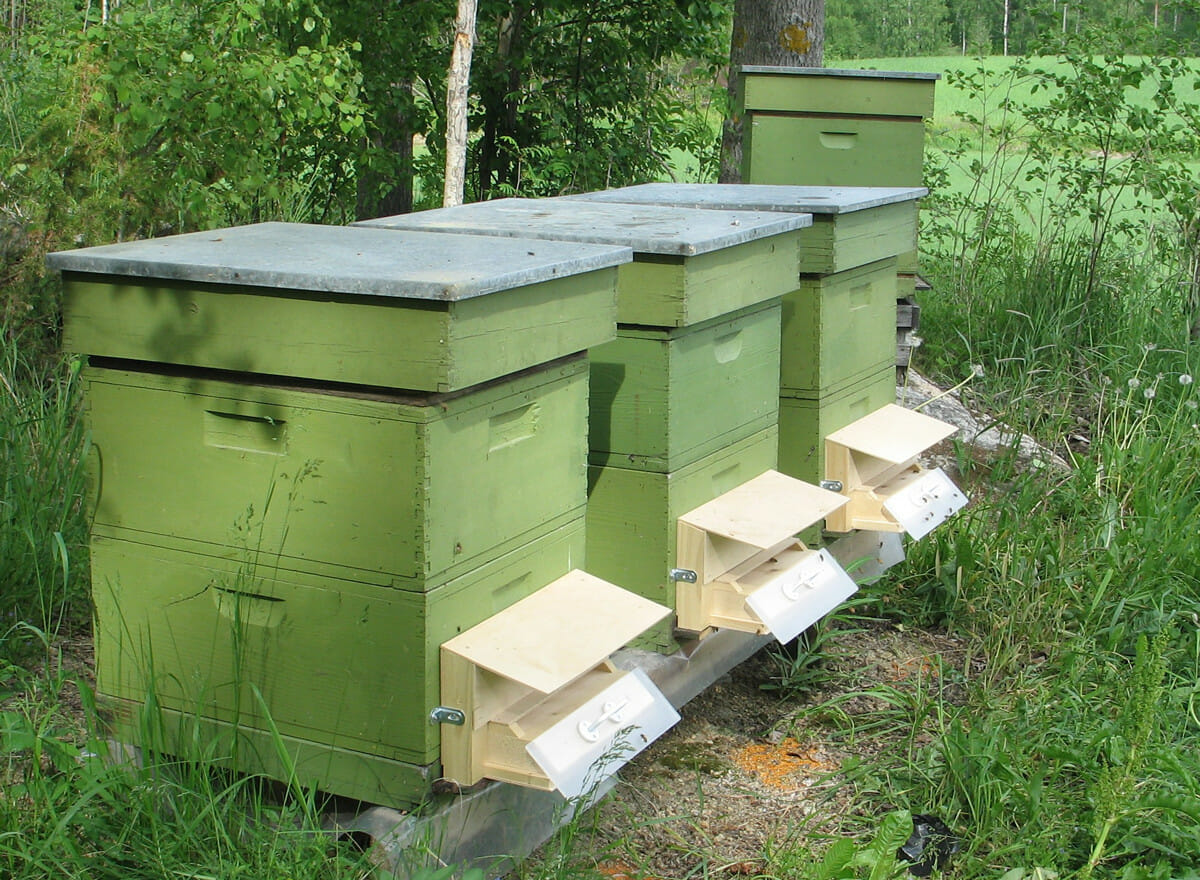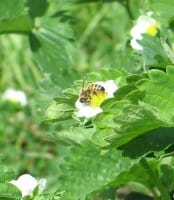Bee Doctors: A New Way to Protect Fruit?
When it comes to ministering to plants, who better than a bee?
Bee Doctors: A New Way to Protect Fruit?
When it comes to ministering to plants, who better than a bee?

The hazards of spraying fungicides and pesticides on fruit and vegetables are well known: increased resistance to their efficacy by pests and weeds, expense of fuel, machinery and labor to apply them and the environmental hazards of runoff and spray drift.
Over the last several years, European fruit farmers have discovered that putting a tray of a safe fungicide powder in front of a hive allows departing bees to get it on their bodies and deliver it more precisely to fruiting flowers than any spray.
Finnish agricultural zoology professor Heikki M.T. Hokkanen first pilot-tested the process against one of the strawberry industry’s greatest nuisances, gray mold, at a strawberry farm in 2006. Gray mold has regularly destroyed between 10-20 percent of the Finnish strawberry crop, costing growers up to EUR 5 million.
Hokkanen devised a beehive attachment – a so-called “two-way dispenser” – that he uses with a bio-control agent called Prestop-Mix, which was designed by Finnish firm Verdera Oy for fungus control and is approved by the European Union for use in organic farming. Hokkanen says the dispenser allows the bees to exit only through the opening that takes them through the microbial powder; the separate hive entrance at the top has no dusting of Prestop. Thus, he says, the bees do not transport the agent “in the wrong direction” (into the hive), but come in with clean feet, having rubbed off the product during their foraging.

Since the pilot, researchers and fruit growers of greenhouse strawberries and raspberries, as well as orchard apples, pears and cherries in Europe and Australia have adopted or least tested the practice. They use products from both Hokkanen’s own company Aasatek Oy and Belgian bumblebee producer Biobest. Although figures on exactly how much less fungicide bee doctoring uses compared with chemical spraying were not immediately available, Hokkanen’s peer-reviewed paper on the pilot says the process is approximately one-third the cost of chemical control.
Jouko MÁ¶nkkÁ¶nen, the strawberry farmer in LeppÁ¤virta, Finland who piloted Hokkanen’s “bee doctor” test, says the practice has also improved his strawberry yields: “When I first started cultivating strawberries 20 years ago, we moved yields per hectare to about 5000 kilos. When the farm started bee farming 10 years ago, that increased yields to between 6,000-9,000 kg. Now, for the last four years, it has not gone below 10,000 kilograms [per hectare].”
But it is the lessened environmental impact on the land that prompted the Finnish Government to subsidize its strawberry, raspberry and apple growers by 500 Euro per hectare if they switch to bee doctoring, says Dr. Katja Hogendoorn, a bee researcher at the University of Adelaide’s School of Agriculture, Food and Wine.
Hogendoorn organized the first demonstration of bee doctoring in Australia last fall with the Cherry Growers Association of South Australia at Lennane Orchards in Montacute. “Brown rot is caused by a fungus, which significantly impacts the $150-million Australian cherry industry through costs of applying fungicide, yield loss and fruit spoilage,” she says. She also used Hokkanen’s hives and Prestop.
Using bees to deliver bio-agents that kill plant disease could clearly cause some to question whether the practice is safe for bees. Hokkanen asserts that Prestop-Mix poses no risk to the bees and does no harm to the berries. Hogendoorn said she lost only one of 20 hives in her cherry orchard test to meat ants and that most of the hives were very heavy, indicating thriving populations.
Both Hokkanen and Hogendoorn say tests have shown that honey from bee doctors contains no traces of the bio-agent or strange flavors.
Biobest presented the bee-doctoring concept to the Bio-Pesticide Industry Alliance (BPIA) conference about 18 months ago. (Aasatek has no sales presence in North America.) However, Dominique Demers, sales manager for Biobest Canada & U.S., says it is only selling the dispenser for its commercial bumblebee hives, as no bio-pesticide in the U.S. is yet approved for use by either honeybees or bumblebees.
A spokeswoman for the U.S. Environmental Protection Agency’s Biopesticides and Pollution Prevention Division (BPPD) said it does not have any guidance on new technology to use bees to deliver biological agents that control diseases in fruit, and has received no application for its use. “If we receive a submission for this use, we will evaluate it under the standards of FIFRA (Federal Insecticide, Fungicide, and Rodenticide Act),” the agency said.
Photos: Heikki Hokkanen, Aastek Oy
Follow us
This work is licensed under a Creative Commons Attribution-NoDerivatives 4.0 International License.
Want to republish a Modern Farmer story?
We are happy for Modern Farmer stories to be shared, and encourage you to republish our articles for your audience. When doing so, we ask that you follow these guidelines:
Please credit us and our writers
For the author byline, please use “Author Name, Modern Farmer.” At the top of our stories, if on the web, please include this text and link: “This story was originally published by Modern Farmer.”
Please make sure to include a link back to either our home page or the article URL.
At the bottom of the story, please include the following text:
“Modern Farmer is a nonprofit initiative dedicated to raising awareness and catalyzing action at the intersection of food, agriculture, and society. Read more at <link>Modern Farmer</link>.”
Use our widget
We’d like to be able to track our stories, so we ask that if you republish our content, you do so using our widget (located on the left hand side of the article). The HTML code has a built-in tracker that tells us the data and domain where the story was published, as well as view counts.
Check the image requirements
It’s your responsibility to confirm you're licensed to republish images in our articles. Some images, such as those from commercial providers, don't allow their images to be republished without permission or payment. Copyright terms are generally listed in the image caption and attribution. You are welcome to omit our images or substitute with your own. Charts and interactive graphics follow the same rules.
Don’t change too much. Or, ask us first.
Articles must be republished in their entirety. It’s okay to change references to time (“today” to “yesterday”) or location (“Iowa City, IA” to “here”). But please keep everything else the same.
If you feel strongly that a more material edit needs to be made, get in touch with us at [email protected]. We’re happy to discuss it with the original author, but we must have prior approval for changes before publication.
Special cases
Extracts. You may run the first few lines or paragraphs of the article and then say: “Read the full article at Modern Farmer” with a link back to the original article.
Quotes. You may quote authors provided you include a link back to the article URL.
Translations. These require writer approval. To inquire about translation of a Modern Farmer article, contact us at [email protected]
Signed consent / copyright release forms. These are not required, provided you are following these guidelines.
Print. Articles can be republished in print under these same rules, with the exception that you do not need to include the links.
Tag us
When sharing the story on social media, please tag us using the following: - Twitter (@ModFarm) - Facebook (@ModernFarmerMedia) - Instagram (@modfarm)
Use our content respectfully
Modern Farmer is a nonprofit and as such we share our content for free and in good faith in order to reach new audiences. Respectfully,
No selling ads against our stories. It’s okay to put our stories on pages with ads.
Don’t republish our material wholesale, or automatically; you need to select stories to be republished individually.
You have no rights to sell, license, syndicate, or otherwise represent yourself as the authorized owner of our material to any third parties. This means that you cannot actively publish or submit our work for syndication to third party platforms or apps like Apple News or Google News. We understand that publishers cannot fully control when certain third parties automatically summarize or crawl content from publishers’ own sites.
Keep in touch
We want to hear from you if you love Modern Farmer content, have a collaboration idea, or anything else to share. As a nonprofit outlet, we work in service of our community and are always open to comments, feedback, and ideas. Contact us at [email protected].by Marsha Johnston, Modern Farmer
March 18, 2015
Modern Farmer Weekly
Solutions Hub
Innovations, ideas and inspiration. Actionable solutions for a resilient food system.
ExploreExplore other topics
Share With Us
We want to hear from Modern Farmer readers who have thoughtful commentary, actionable solutions, or helpful ideas to share.
SubmitNecessary cookies are absolutely essential for the website to function properly. This category only includes cookies that ensures basic functionalities and security features of the website. These cookies do not store any personal information.
Any cookies that may not be particularly necessary for the website to function and are used specifically to collect user personal data via analytics, ads, other embedded contents are termed as non-necessary cookies.